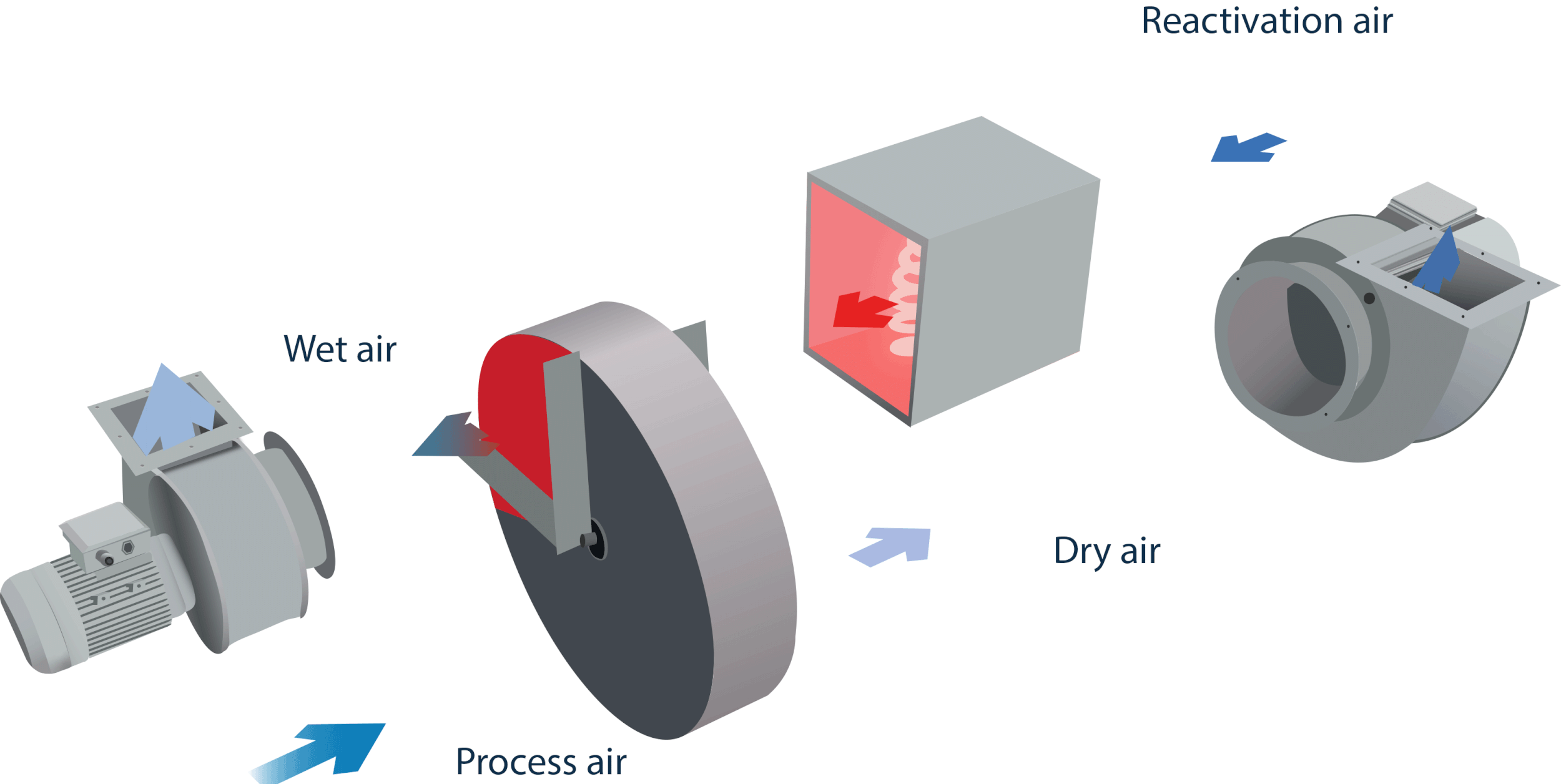Choosing the Right Dehumidifier
Refrigerant (Mechanical) or Desiccant (adsorption) Dehumidifier
Firstly, we need to know what is the desired temperature and humidity along with the heat and moisture removal requirements?
When Humiscope is looking at the best drying solution for a client, and choosing one dehumidifying option over another, our initial research places equal emphasis on the necessary air temperature and the desired humidity level.
These two factors, temperature, and humidity are closely interconnected. However, the required temperature of a given space plays a pivotal role in the dehumidification technology we choose.
Two Main Types of Dehumidifiers
There are two main types of commercial dehumidifier – refrigerant and desiccant. They both lower humidity but do so in quite different ways, which frequently determines when you should use one instead of the other.
One of the Desiccant Dehumidifiers Humiscope supplies
One of the Refrigerant Dehumidifiers Humiscope supplies
Understanding Humidity and Dehumidifiers
When the air is warmer (between 10 and 32°C), it's easier to remove moisture from it if you cool it down. This is because cooling the air makes the relative humidity (RH) increase and approach its dew point (gets closer to the point where the water vapor turns into liquid). So, for warm, humid air (over 40% RH), refrigerant systems work better. But for cooler air with lower humidity, using a desiccant dehumidifier is more effective. In cooler temperatures, refrigerant systems can freeze up, which impacts their overall efficiency.
The Extraction of Humidity
The extraction of water from the air, transitioning it from a gaseous to a liquid state, generates heat. This is a fundamental principle for both major dehumidifier types: refrigerant and desiccant. During the dehumidifying process, both systems produce heat. The way this heat is managed can significantly influence the complexity and cost of a project, depending on the specific drying needs.
To achieve the desired room conditions effectively, it's crucial to meticulously consider and calculate thermal management alongside moisture removal.
Desiccant Dehumidifying Process
Humiscope’s commercial and industrial desiccant dehumidifiers eliminate moisture from the air by adsorbing it using a slowly rotating desiccant rotor. The desiccant rotor (or wheel) contains silica (think of the little sachets you find on shoe boxes that absorb moisture). The desiccant rotor takes in moisture from the airflow passing through it.
To prevent saturation, a section of the rotor is exposed to hot air during its rotation, a process known as regeneration. This hot, dry air carries low relative humidity and releases water from the desiccant wheel as it revolves through the regeneration zone. This moisture-laden regeneration air is then expelled externally, ridding it of the moisture and ensuring continuous air drying by the dehumidifier.
In this desiccant dehumidifying process, moisture adsorption generates heat. About 680 watts of heat are produced for every kilogram of removed moisture. Additionally, there's residual heat transferred from the regeneration area to the process air as the wheel moves from hot to cool areas. This effect can contribute 1-3°C of warmth per gram of removed moisture.
Therefore, the desiccant dehumidification process not only extracts moisture but also adds latent heat to the process airflow. To counterbalance this, a cooling coil can be integrated either after (post-cooling) or before (pre-cooling) the desiccant drying process. This coil moderates the air temperature back toward the room's ambient temperature.
Refrigerant Dehumidifying Process
In contrast, a Humiscope refrigerant dehumidifier extracts moisture by creating a cold surface where water vapor condenses. It cools the air below its dew point using the evaporator side of a standard refrigerant circuit and then rewarms the dried air with the circuit's hot condenser side. The treated air is then supplied to the room while the condensed moisture is then drained via a hose to the outdoor environment.
For refrigerant dehumidifiers, ambient temperature is especially crucial. The process of condensation becomes less efficient at lower ambient temperatures. Unlike desiccant systems, which work irrespective of ambient temperature, refrigerant dehumidifiers are most effective at temperatures of 20°C or higher.
While refrigerant dehumidifiers don't contribute as much heat as desiccant systems, there is still thermodynamic heating due to moisture turning into liquid. This leads to the output air being warmer than the input air.
In Conclusion
To sum up, successful dehumidification projects necessitate the evaluation of both humidity and temperature requirements. It's imperative to consider the supply air's temperature to the dehumidifier, the acceptable room temperature, and how the heat generated during the drying process can be managed.
When in doubt, seeking advice from an expert in commercial and industrial dehumidification systems, is ideal. At Humiscope, we can provide detailed information about the exact heat gain from any dehumidification process and suggest solutions to ensure the desired room conditions are met in terms of both humidity and temperature.





